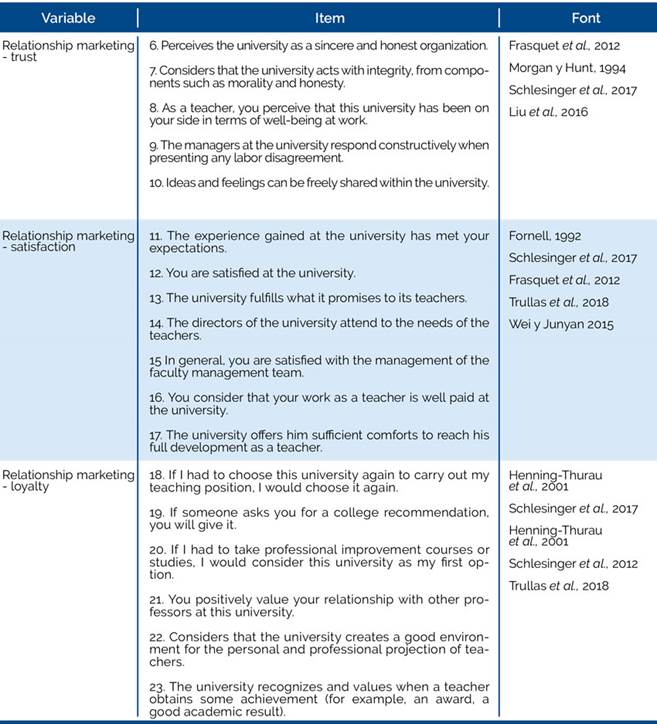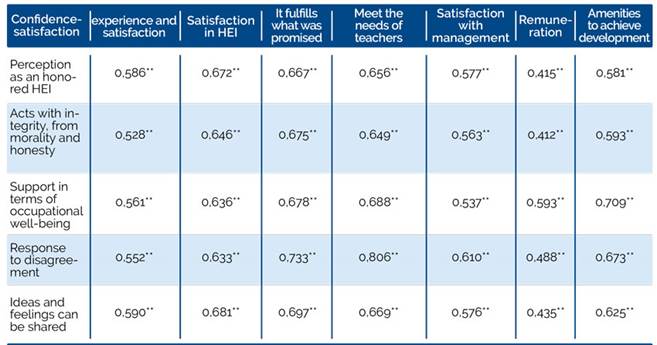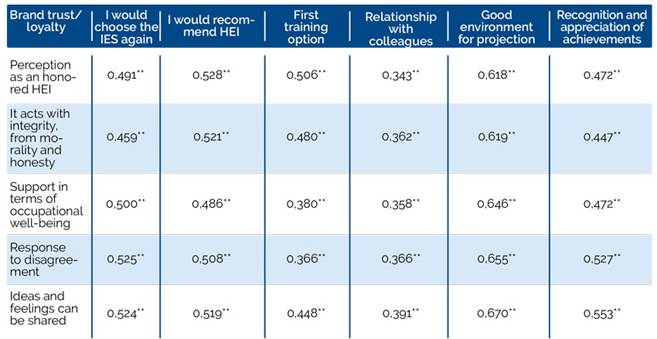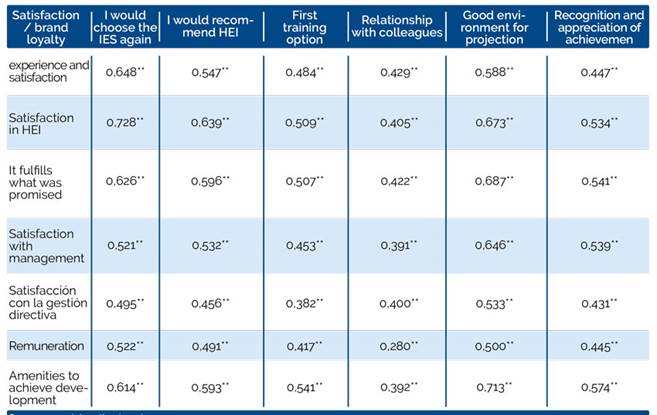From transactional marketing to marketing relational to build community in university teachers1
Del mercadeo transaccional al mercadeo relational para construir comunidad en los docentes universitarios
Abstract
Transactional marketing has been transformed into relational marketing in university management models, the main objective of this research is to establish the relationship between the main variables of relational marketing: trust, satisfaction, and loyalty to build community in university teachers. The methodology used is quantitative, with a sample of 287 teachers belonging to institutionally accredited Universities in the city of Medellín, Colombia. As a result, it is obtained hat strategies must be built to consolidate trust, since this is the basis of all relationships. The level of satisfaction is adequate; however, it does not necessarily lead to the loyalty of teachers in the institutions. The relationship to strengthen and consolidate value propositions is valued positively. Teachers consider that there is a good environment for personal and professional projection, since it has a significant influence on confidence and satisfaction.
Keywords:
relational marketing, Teachers, University.Resumen
El mercadeo transaccional se ha venido transformando en mercadeo relacional en los modelos de gestión de las universidades, el objetivo principal de esta investigación es establecer la relación entre las principales variables del mercadeo relacional: confianza, satisfacción y lealtad para construir comunidad en los docentes universitarios. La metodología utilizada es cuantitativa, con una muestra de 287 docentes pertenecientes a universidades acreditadas institucionalmente en la ciudad de Medellín, Colombia. Como resultado se obtiene que se deben construir estrategias para consolidar la confianza, ya que esta es la base de todo relacionamiento. El nivel de satisfacción es adecuado, sin embargo, no necesariamente conduce a la lealtad de los docentes en las instituciones. Se valora positivamente el relacionamiento para fortalecer y consolidar propuestas de valor. Los docentes consideran que se cuenta con buen ambiente para la proyección personal y profesional, ya que influye significativa en la confianza y en la satisfacción.
Palabras clave:
mercadeo relacional, docentes, universidad.Introduction
In current times, with the history of reengineering, massive layoffs, outsourcing and plant closures; the trust, loyalty and satisfaction of workers towards companies can be considered a contradiction (Gutiérrez, 2013; Riccomini et al ., 2021). The fact that there is no trust and loyalty on the part of the employees towards the organizations for which they work, speaks of their perception that the company is only pursuing the achievement of its objectives, and is leaving aside the personal goals of their collaborators (Rylander et al., 1997). On the contrary, if a relational model is built that involves the performance of the companies and the compliance and commitment of the workers, through the commitment of the organization with the learning of the employees with the company, a contribution to improvement can be achieved. of organizational performance (Buenaventura-Vera and Gudziol, 2020).
If this general scenario is transferred to the educational field, it could be said that the same situation is also experienced. The lack of this involvement between the collaborators and the institution for which they work can also have results abroad, reflected in the low loyalty and high dropout rate of the students (Correa, 2019; Jain et al., 2022).
Then the teacher appears as that public of internal interest and a fundamental part of the educational offer, who becomes a great influencer to keep the student population connected to the university (Gómez-Bayona et al., 2020), here lies the importance that he be her promoter thanks to the level of involvement he feels for her. It makes sense then that institutions focus their efforts on relational strategies that are aimed at this audience and that promote the construction of brand value ( Gómez-Bayona et al ., 2019), since it has been shown that part of the personal development of a student can be explained by the teacher-student social relationship, thereby improving their academic commitment and sense of belonging to the institution (Tarı and Mercan, 2020).
If satisfaction and trust are the previous and necessary steps to achieve brand loyalty (Guadarrama and Rosales-Estrada, 2015; Riccomini et al ., 2021), it is important for HEIs to understand what are the possibilities for improvement in these two first steps, to finally achieve the dimension of loyalty among their teaching group. Understanding that loyalty is known in the academic field as the commitment that people have to enroll in an educational institution that will train them for the future, and thus recommend it to others (Cavazos and Encinas, 2016), thus helping the establishment of a long-term relationship (Encinas and Cavazos, 2017).
Some research has been carried out that deepens aspects of trust, shared value, identity and satisfaction (Morgan and Hunt, 1994; Wei and Junyan 2015; Schlesinger et al ., 2017; Trullas et al ., 2018; Gómez-Bayona et al ., 2019), but it is necessary to continue exploring and deepening relational marketing in educational institutions and mainly in Latin America. From this approach, the research question for this article is derived: How is there a relationship between the main variables of relational marketing: trust, satisfaction, and loyalty to build community in university teachers? To answer this question, an exploratory bibliographic search has been carried out in databases such as Scopus, Science and Google Scholar; then, the application of a measurement instrument aimed at HEI teachers was carried out and then a statistical analysis was carried out that showed the level of relationship between the variables (satisfaction, trust and loyalty). Finally, some strategies were proposed that will serve as a model for institutions to apply within their relational management with this internal public.
Theoretical framework
educational marketing
It is an important administrative function, without it, educational institutions could not survive in today’s competitive environment (Oplatka, 2006).
There are some mediating factors in terms of competition and position of the institutions that are attractive determinants to capture students and achieve better satisfaction, loyalty and acquire more academic services (Hemsley-Brown and Oplatka, 2006; Zancajo, 2018). Likewise, educational marketing are the actions that are generally carried out in the management of a wide and dynamic range of external and internal relationships that include promotion, sale and public relations (Beerli et al ., 2002), configuring the strategic response to the introduction of marketing-oriented policies and competitive environments (Arar et al ., 2017). The foregoing allows us to contextualize how valuable an adequate planning is for the management of managers and in coherence with the needs of the market. Some approaches have been evidenced that have tried to articulate the audiences that make up the academic community and that have segmentation and service quality as a management tool (Zeithaml et al., 1988); however, they make it known that, although marketing is the key to making management sustainable, it is little explored or used (Akpayeva et al., 2016). This generates concern, since the universities are in charge of providing guidelines both for the administration itself and for those who are trained in their university cloisters and who will be the ones who lead the different sectors of the economy in the future (Hamid 2016; Richart et al., 2019).
Various tools have been found to apply marketing actions in universities and with different audiences: some bet on quality (Sanz et al., 2017); at service (Hennig-Thurau et al ., 2001); to marketing (Bennett and Ali-Choudhury, 2009), to satisfaction (Amoli and Aghashahi, 2016), and others have wanted to give marketing the differentiating characteristic and move from the transactional to the relational paradigm, in order to be closer to the needs of individuals, knowing their tastes and expectations and from there, building a lasting relationship that benefits the parties (Osayawe and Taylor, 2009; Schlesinger et al ., 2015; Schlesinger et al ., 2016) and that promotes loyalty of the students (Hennig et al ., 2001), of the teachers and of all the stakeholders that interact with the university institution (Adeogun, 2022).
Relationship marketing in education
It is given in response to a need of society: that of identifying, satisfying, and retaining the public (Poole and Campos, 2017). Previously, transactional, or traditional marketing was applied with a conservative structure that, although effective, was postponed over time. The hyperconnectivity that is currently experienced thanks to technology has caused changes to be made in the traditional relationship paradigm, leading to long-term business relationships (Dorozhkin et al ., 2016), thus, relationship marketing is defined as that process to identify, improve and maintain relationships that are beneficial to come to consider loyal customers (Mynbayeva and Yessenova, 2016) in which satisfaction is detected (James et al ., 2019).
The purpose of this marketing is that the clients themselves appropriate the brand and become validators because they feel identified with the brand (Schlesinger et al ., 2012). In the same way that organizations in any sector, in education they have understood that it is necessary to carry out relational marketing strategies, because as Guilbault (2016) and Gummesson (2002) mention, it has become more expensive to get a new client than to keep one (Manzuma -Ndaaba et al., 2018). This is reaffirmed in the educational context, by demonstrating the close relationship between the variables of satisfaction, trust, and commitment, with the loyalty that students feel towards their institution (Galindo-Illanes et al., 2021).
That is why companies from different economic sectors should not give customers to the competition (Du et al., 2010), they must create strategies to satisfy customer wishes and thus generate added value that attracts the public. and allow the satisfaction of your needs.
Methodology
Sample and measurements
A simple random sample of 287 teachers who are part of public and private universities in Medellín, Colombia, was defined, to whom an instrument was sent by email. Data collection was carried out between January and August 2020.
The instrument consists of twenty-three closed questions (Table 1), of which 6 are sociodemographic and 17 were measured on a five-point Likert scale. These 17 questions were distributed to measure the levels of trust, loyalty and brand satisfaction that contribute to the consolidation of relationship marketing. It is necessary to mention that there are some variables such as shared value, commitment, trust, satisfaction, and loyalty, among others, that define the consolidation of relational marketing, however, for this research project only the last three were selected to focus the contribution they bring to marketing consolidation. Some studies have been developed on trust, satisfaction and loyalty that have served as support for this article and from this study it is expected to continue exploring and contributing to the construction of the marketing discipline (Morgan and Hunt, 1994; Wei and Junyan, 2015). Schlesinger et al., 2017 Trullas et al ., 2018; Gómez-Bayona et al ., 2019).
Source: own elaboration (2022)
Tabla 1: Scales used in the questionnaire.

Bearing in mind that the objective of this research is to establish the relationship between the main variables of relational marketing: trust, satisfaction, and loyalty to build community in university teachers, the following hypotheses were tested: trust is associated with the employee’s perception that the organization for which he works cares about him, satisfaction is associated with feelings for the work group and working conditions. Trust and satisfaction are fundamental variables in relational marketing, both are closely related to organizational commitment according to Gutiérrez (2013) . It is important to highlight that this topic is not very well evidenced in the educational field in the existing bibliography, since this relationship has not been studied or confirmed. Loyalty is the action of systematically preferring a brand over time, which is achieved through high levels of trust towards the organization. Loyalty must be understood as the last link that brands reach when carrying out an integral management in the other variables of relational marketing.
H1: The main variables of relationship marketing are trust, satisfaction, and loyalty.
H2: Trust is significantly associated with satisfaction.
H3: Trust and satisfaction are significantly associated with brand loyalty.
Additionally, to analyze reliability, the Cronbach’s alpha test was performed, which statistically presented a value > 0.95, this being an internal consistency of the instrument. Both the trust scale and the brand loyalty scale are reliable because the results obtained in the Cronbach’s alpha coefficient indicate that a significant change in the internal consistency reliability of the instrument is not perceived if any of the variables it measures is eliminated. each construct (Rodríguez-Rodríguez and Reguant-Álvarez, 2020) .
Now, to determine the relationship between satisfaction, trust and brand loyalty, the results were analyzed at a descriptive and inferential level, for the latter case the Spearman correlation test was used with the statistical software SPSS at a level of significance of 5% (=0.05) (Reguant-Alvarez et al., 2018).
Results and Discussion
Analysis of the relationship between the constructs of relational marketing
Regarding the demographic variables, it was found that variables such as sex, age range, marital status, current level of study, HEI to which he is linked and time of linkage in the HEI, the only one that presents a significant relationship (p = <0.05) with each of the scales of the constructs of trust, satisfaction and brand loyalty, however, these associations are weak, since the Spearman correlation coefficient is less than 0.2.
Association between trust and satisfaction
Regarding the relationship between satisfaction and trust, there is a statistical association between the scales that measure each variable (p = < 0.000). Table 2 shows that these associations are between moderate and strong since Spearman’s Rho coefficient is between 0.51 and 0.75. The strong associations are found between the relationships of: The directors in the university respond constructively when presenting some labor disagreement belonging to the construct of trust with the directors of the university attend to the needs of the teachers belonging to the construct of satisfaction with a Rho = 0.806 and with the university he fulfills what he promises to his teachers Rho = 0.733, the weak relationships are found each in the relationships between trust, considering that his work as a teacher is well paid at the university which are below 0.50 belonging to the satisfaction construct.
Source: own elaboration (2022)
Table 2: Correlations between trust and satisfaction.

Part of the results evidenced in table 2 show that aspects such as the salary remuneration of the teacher do not strongly affect the levels of trust with the institution, therefore aspects such as the recognition and visibility of the teacher within the educational processes will be strategic to further consolidate trust and that economic aspects do not directly influence the consolidation of integrity and honesty. Likewise, it is found in the results that the perception of teachers in aspects of labor welfare is positive and that this contributes greatly to the construction of trust and generates great satisfaction in educational environments to consolidate the management that is carried out. in aspects of teaching, social projection, and research. In the same way as mentioned by Oplatka and Hemsley-Brown (2012), to the extent that the management of managers in academic environments is purposeful and contributes significantly to the development of teachers, this will result in greater and better construction aspects such as trust and satisfaction.
Association between trust and brand loyalty
With respect to brand loyalty, it is observed, according to table 3, that trust has strong relationships with the brand loyalty variable “Considers that the university generates a good environment for the personal and professional projection of teachers”, the Spearman’s Rho coefficients are between 0.618 and 0.67, however, trust has weak relationships with the variables, even considering a university as the first option and with “You positively assess your relationship with other teachers at this university” of the variable brand loyalty, especially in the latter, where Spearman’s Rho coefficient is between 0.343 and 0.391.
Source: own elaboration (2022).
Table 3: Correlations between trust and brand loyalty.

As evidenced in Table 3, the “Willingness to choose the institution where one works to carry out professional improvement studies” has very little relationship with the dimension of trust, since the fact that said willingness is high or low it does not influence the “integrity, morality and interest that teachers perceive from the university towards their employees”. This result goes against the approach of Keller (2008) who states that one of the elements that generates loyalty is the trust felt about the brand. The way in which teachers “value relationships with their colleagues” does not reveal a strong relationship between this aspect and the “trust they may feel for the institution in which they work”.
On the contrary, the highest correlation was found between the loyalty variable, in which it was inquired whether “In the university a good environment is generated for the personal and professional projection of teachers”, and the other trust variables. This question did represent a strong relationship with the trust variables where “Sincerity, integrity, perception of work well-being, interest on the part of managers and freedom to share ideas” were inquired. Correa ‘s approach (2019) makes sense when he proposes that the involvement of the collaborator is achieved in the face of the employee’s perception that the company pursues organizational objectives but must also ensure the personal and professional objectives of its people.
Association between satisfaction and brand loyalty
Según la tabla 4, las relaciones fuertes entre estos dos constructos se dan en “Si tuviera que elegir According to table 4, the strong relationships between these two constructs occur in “If I had to choose this university again to hold my teaching position, I would choose it again” of the brand loyalty variable and the variables that make up the satisfaction constructor. Since Spearman’s Rho coefficient is found to be <0.5, especially with the variable “Is satisfied at university”, where this coefficient is 0.728, being even the strongest relationship between the constructs of brand loyalty and satisfaction. The weak relations are found between “You positively value your relationship with other professors at this university” of the brand loyalty variable, especially with the satisfaction variable “You consider that your work as a professor is well paid at the university”, where coefficient of Spearman’s Rho (= 0.28), even representing this value the lowest association of the set of relationships that exist between the three constructs of trust, satisfaction and loyalty in relationship marketing. These variables make it possible to identify the commitment and durability over time with the aim of generating profitability and sustainability for the parties involved.
Source: own elaboration (2022).
Tabla 4: Correlaciones entre conflanza y lealtad de marca.

The results evidenced in the previous table allow us to find the weakest relationships in the assessment of the relationship with other teachers, so it is important to strengthen aspects of teamwork that allow a better closeness between them to generate better collaborative work that leads them to the construction of internal and external projects, consolidation of networks and greater visibility, as Veretennik and Kianto show (2020), the construction of networks between teachers in their work teams allows generating an exchange of knowledge, strengthening trust and impacting the job satisfaction of teachers, generating an environment of stability within the organization. Kureshi and Thomas (2020) mention that aspects such as those mentioned above allow higher satisfaction rates and lead the teacher to refer to the institution where he works, perceive a better closeness to the organization and generate greater communication with the people who are part of it. of the academic community, thus achieving not only better teamwork, but also better two-way communication between teachers and academic directors (Oplatka, 2006) so that lasting relationships are built and the alternative of believing in the university brand and in the services offered, leading to satisfaction and loyalty in academic and administrative processes (Poole and Campos, 2017; Riccomini et al ., 2021).
Conclusions
After the results obtained in this research, it is evident that loyalty is the variable that must be strengthened, especially with the retention and loyalty variables so that teachers become brand validators and recommend the HEIs where they work.
In terms of satisfaction, the relationship variables with managers or those who make academic and administrative decisions should be strengthened, since from there good actions can be generated that allow a positive prospective in HEIs.
Likewise, it is considered that strategies should be carried out that empower teachers in HEIs and that from there an adequate trust is built so that this is transformed into satisfaction and the loyalty of human talent, making teachers refer to HEIs, recommend and consider them as the first option to improve their studies or that of their family or friends. Likewise, it is synthesized in this research that HEIs must verify how by improving the organizational climate, it can improve trust in the organization and build a strong relationship that becomes more and better alternatives for growth.
It is important that HEIs systematically carry out the internal measurement of the main relationship indicators, which allow them to have an overview of how the teaching community is perceiving the management that the institution carries out. For this, periodic measurements of satisfaction, loyalty and recommendation become important, which may throw traffic lights where good practices and opportunities for improvement are evidenced for each of the institutions, as well as the level of involvement of the apostle, neutral or detractor type that teachers have with your brand.
To conclude this research, some relational marketing strategies are proposed, taking as a guide some schemes such as those of Gómez-Bayona et al., (2020) where they propose gamification as a value strategy in HEIs and from the construction of organizational culture. This is how the strategies with a focus on relational marketing are proposed as follows:
-
Construction of the objective of institutional marketing with a relational approach in the IES.
-
Integration of the different groups that are part of the academic community.
-
Identify the motivation of the interest groups (especially teachers) who will participate in the educational marketing strategy with a relational approach.
-
Consolidate work teams to raise awareness of the importance of marketing in HEIs.
-
Strengthen aspects such as satisfaction, loyalty, and trust in educational marketing strategies.
-
Generate work roles with intentionality in the strategies proposed from the marketing area.
-
Monitor and control these strategies.
-
Generate culture in HEIs of the importance of relational marketing to generate value.
Considering the previous work path, a better development of marketing with a relational approach in educational institutions can be guaranteed, where it starts from awareness of the importance of building culture in marketing and the articulation with the different audiences with teachers, who are the most strategic and intentional in this management process.
It is expected that this research contributes significantly to those who lead marketing processes in HEIs and understand the importance that this discipline brings to generate value and to grow in the organizational fabric.